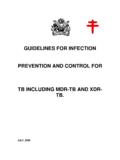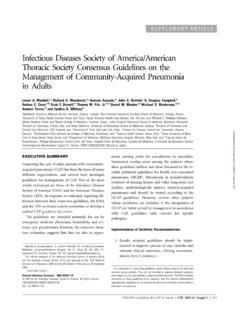Transcription of Guidelines for Capital Accumulation Plans - Joint …
1 Joint Forum of Financial Market Regulators Forum conjoint des autorit s de r glementation du march financier GGuuiiddeelliinneess ffoorr CCaappiittaall AAccccuummuullaattiioonn PPllaannss MMaayy 2288,, 22000044 5160 Yonge Street, Box 85, 17th Floor, North York, ON M2N 6L9 Telephone: 416-590-7054; Facsimile: 416-590-7070 Table of Contents May 28, 2004 Capital Accumulation Plan Guidelines TABLE OF CONTENTS Section 1: - - The Purpose of the - Implications for the CAP Sponsor, Service Providers, and CAP Section 2: Setting Up a - - Investment - Maintenance of Section 3: Investment Information and Decision-Making Tools for CAP - - Investment - Investment Decision-Making - Investment Section 4: Introducing the Capital Accumulation Plan to CAP - - Investment - Transfer - Description of Fees, Expenses and - Additional Section 5: Ongoing Communication to - Member - Access to - Performance Reports for Investment Section 6.
2 Maintaining a - Reviewing Service - Reviewing Service Providers who Provide Investment - Reviewing Investment - Reviewing Maintenance of - Reviewing Decision-Making Section 7: - Terminating a - Terminating a CAP Member s Participation in the Section 1: Introduction May 28, 2004 Capital Accumulation Plan Guidelines 1 SECTION 1: INTRODUCTION These Guidelines reflect the expectations of regulators regarding the operation of a Capital Accumulation plan, regardless of the regulatory regime applicable to the plan. They are intended to support the continuous improvement and development of industry practices. Shaded text within the document is included as elaboration and clarification of the Guidelines for the purpose of assisting the user. - DEFINITIONS Capital Accumulation Plan In these Guidelines , a Capital Accumulation plan (CAP or plan) is a tax assisted investment or savings plan that permits the members of the CAP to make investment decisions among two or more options offered within the plan.
3 A CAP may be established by an employer, trade union, association or any combination of these entities for the benefit of its employees or members. Examples of a CAP may include a defined contribution registered pension plan; a group registered retirement savings plan or registered education savings plan; and a deferred profit sharing plan. CAP Sponsors In these Guidelines , the employers, trade unions, associations or combinations of these entities that establish CAPs are referred to as CAP sponsors . If the CAP is a registered pension plan, many of the responsibilities of the CAP sponsor described in these Guidelines are those of a pension plan administrator. In such cases, these Guidelines should be interpreted considering the different roles of employers and pension plan administrators under applicable pension benefits standards legislation. Service Providers In these Guidelines , service providers include any provider of services or advice required by the CAP sponsor in the design, establishment and operation of a CAP.
4 CAP Members In these Guidelines , CAP members are individuals who have assets in a CAP. These individuals may include active or former employees; trade union or association members; and in certain cases, their spouses or common law partners. Investment Funds In these Guidelines , an investment fund means a mutual fund, pooled fund, segregated fund or similar pooled investment product. - THE INTENT OF THE Guidelines The intent of these Guidelines is to: outline and clarify the rights and responsibilities of CAP sponsors, service providers and CAP members; and, ensure that CAP members are provided the information and assistance that they need to make investment decisions in a Capital Accumulation plan. Application of the Guidelines These Guidelines apply to all Capital Accumulation Plans and supplement any legal requirements applicable to these Plans . They do not replace any legislative requirements.
5 CAP sponsors are responsible for meeting any applicable legal requirements, including any requirements that may extend beyond the scope of these Guidelines . Section 1: Introduction May 28, 2004 Capital Accumulation Plan Guidelines 2 - IMPLICATIONS FOR THE CAP SPONSOR, SERVICE PROVIDERS, AND CAP MEMBERS The CAP Sponsor When CAP sponsors decide to establish a plan, they assume certain responsibilities in their role as CAP sponsor. CAP sponsors may delegate their responsibilities within a CAP to a service provider. The CAP sponsor is responsible for: setting up the plan; providing investment information and decision-making tools to CAP members; introducing the plan to members; providing on-going communication to members; maintaining the plan; and, ensuring that termination of the plan or the membership of an individual within the plan is done in accordance with the terms of the CAP.
6 Many of the responsibilities of the CAP sponsor relate to the provision of information and documents to CAP members. Information and documentation that the CAP sponsor provides to CAP members should be prepared using plain language and in a format that assists in readability and comprehension. The CAP sponsor should ensure that decisions about establishing and maintaining the plan and information about how those decisions are made, are properly documented and that the documents are retained. Service Providers To the extent that the responsibilities of the CAP sponsor are delegated to a service provider, the service provider is responsible for following these Guidelines and any applicable legal requirements. Service providers engaged by the CAP sponsor should have the appropriate level of knowledge and skill to perform the tasks delegated and to provide any advice within their area of expertise requested by the CAP sponsor.
7 CAP Members CAP members are responsible for making investment decisions within the plan and for using the information and decision-making tools made available to assist them in making those decisions. Examples of decisions made by CAP members include: how much to contribute (where the member can make this choice); how much they should contribute to any particular investment option; and, whether an investment in a particular option should be moved to another option. CAP members should also consider obtaining investment advice from an appropriately qualified individual in addition to using any information or tools the CAP sponsor may provide. Section 2: Setting up a CAP May 28, 2004 Capital Accumulation Plan Guidelines 3 SECTION 2: SETTING UP A CAP - GENERAL Defining the Purpose of a CAP CAP sponsors should clearly define and document why the Capital Accumulation plan is being established.
8 The terms of the plan should be consistent with its purpose and what CAP members are told. Some of the purposes for which a CAP sponsor may establish a Capital Accumulation plan are: retirement savings; tax efficient compensation; profit sharing; and, savings for other financial goals such as education, home purchase, etc. If the CAP sponsor decides to modify the purpose of a Capital Accumulation plan, the modified terms of the plan should be consistent with the modified purpose of the CAP. The decision to change the purpose of the plan and the modified purpose of the plan should be documented. Information on the decision and the impact the decision will have on CAP members should be provided to the members before the decision takes effect. Deciding whether to use Service Providers The CAP sponsor should decide if it has the necessary knowledge and skills to carry out the responsibilities set out in these Guidelines and all relevant legal requirements.
9 The CAP sponsor should also decide whether and how service providers should be used. Where the CAP sponsor does not have the necessary knowledge and skills to carry out its responsibilities, service providers should be used. Selecting Service Providers The CAP sponsor should establish criteria for the selection of service providers and use these criteria to select any service providers it engages. Factors for the CAP sponsor to consider when establishing criteria for selecting service providers may include: professional training; experience; specialization in the type of service to be provided; cost of the service; understanding of employee benefits, pension legislation and other related rules; consistency of service offered in all geographical areas in which members reside; and, quality, level and continuity of services offered. Where the CAP sponsor delegates responsibilities to a service provider, the CAP sponsor should ensure that the applicable roles and responsibilities of the CAP sponsor and service provider are carefully documented.
10 Section 2: Setting up a CAP May 28, 2004 Capital Accumulation Plan Guidelines 4 - INVESTMENT OPTIONS Selecting Investment Options The CAP sponsor should select investment options to be made available in the plan. The investment options for CAPs may be limited by legislation. CAP sponsors must comply with all applicable legislative requirements when choosing investment options. Examples of investment options include: investment funds; guaranteed investment certificates (GICs); annuity contracts; employer securities; government securities; other securities; and, cash. The CAP sponsor should ensure a range of investment options is made available taking into consideration the purpose of the CAP. In some cases the choice of a service provider will define or limit the type of investment options available to a plan. Factors a CAP sponsor should consider when choosing investment options, including any default option that may be selected by the CAP sponsor (see Section ), include: the purpose of the CAP; the number of investment options to be made available; the fees associated with the investment options; the CAP sponsor s ability to periodically review the options; the diversity and demographics of CAP members; the degree of diversification among the investment options to be made available to members; the liquidity of the investment options; and, the level of risk associated with the investment options.





